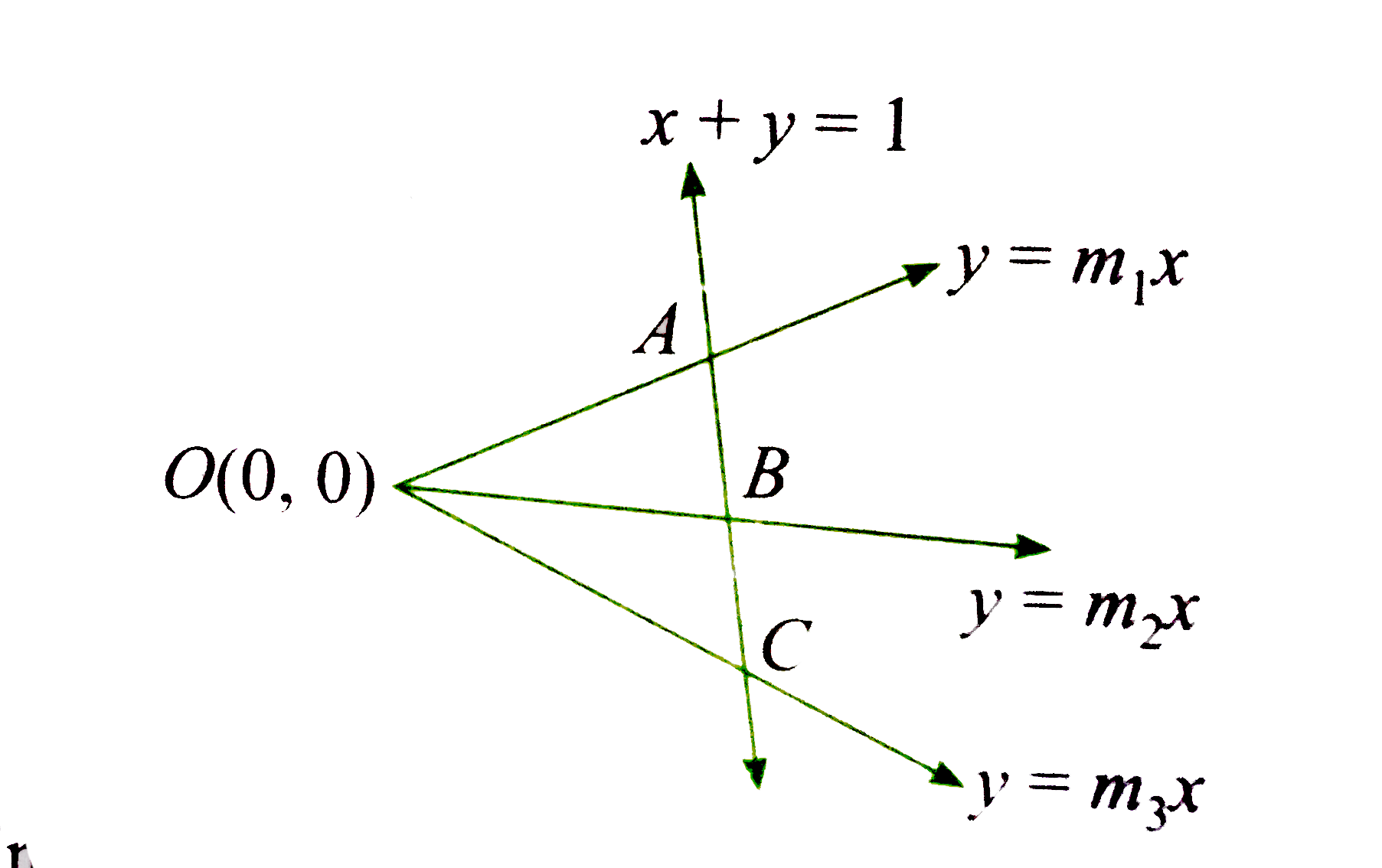The lines y=m1x,y=m2xandy=m3x make equal intercepts on the line x+y=1. Then 2(1+m1)(1+m3)=(1+m2)(2+m1+m3) (1+m1)(1+m3)=(1+m2)(1+m1+m3) (1+m1)(1+m2)=(1+m3)(2+m1+m3) 2(1+m1)(1+m3)=(1+m2)(1+m1+m3)
2(1+m1)(1+m3)=(1+m2)(2+m1+m3)
(1+m1)(1+m3)=(1+m2)(1+m1+m3)
(1+m1)(1+m2)=(1+m3)(2+m1+m3)
2(1+m1)(1+m3)=(1+m2)(1+m1+m3)
The correct Answer is:A

Solving the equations of the lines, we get
A≡(11+m1,m11+m1),C≡(11+m3,m31+m3)
If AB=BC, then the midpoint of AC lies on
y=m2x
or m11+m1+m31+m32=m2⎡⎢⎣11+m1+11+m32⎤⎥⎦
Topper's Solved these Questions
- STRAIGHT LINESBOOK - CENGAGE PUBLICATIONCHAPTER - STRAIGHT LINESEXERCISE - EXERCISE (MULTIPLE CORRECT ANSWERS TYPE)
30 Videos
- STRAIGHT LINESBOOK - CENGAGE PUBLICATIONCHAPTER - STRAIGHT LINESEXERCISE - EXERCISE (LINKED COMPREHENSION TYPE)
27 Videos
- STRAIGHT LINESBOOK - CENGAGE PUBLICATIONCHAPTER - STRAIGHT LINESEXERCISE - CONCEPT APPLICATION EXERCISE 2.6
5 Videos
- STRAIGHT LINEBOOK - CENGAGE PUBLICATIONCHAPTER - STRAIGHT LINEEXERCISE - Multiple Correct Answers Type
8 Videos
- THEORY OF EQUATIONSBOOK - CENGAGE PUBLICATIONCHAPTER - THEORY OF EQUATIONSEXERCISE - JEE ADVANCED (Numerical Value Type )
1 Videos
Similar Questions
The lines y=m1x,y=m2xandy=m3x make equal intercepts on the line x+y=1. Then (a) 2(1+m1)(1+m3)=(1+m2)(2+m1+m3) (b)(1+m1)(1+m3)=(1+m2)(1+m1+m3) (c)(1+m1)(1+m2)=(1+m3)(2+m1+m3) (d)2(1+m1)(1+m3)=(1+m2)(1+m1+m3)
View SolutionThe lines y=m1x,y=m2x,andy=m3x make equal in- tercepts on the line x+y=1. then
View Solution
Knowledge Check
If the transversal y=mrx:r=1,2,3 cut off equal intercepts on the transversal x+y=1 then 1+m1,1+m2,1+m3 are in
AA.P.BG.P.CH.P.DNone of these
The lines y=m1x,y=m2xandy=m3x make equal intercepts on the line x+y=1. Then (a) 2(1+m1)(1+m3)=(1+m2)(2+m1+m3) (b)(1+m1)(1+m3)=(1+m2)(1+m1+m3) (c)(1+m1)(1+m2)=(1+m3)(2+m1+m3) (d)2(1+m1)(1+m3)=(1+m2)(1+m1+m3)
View SolutionIf the transversal y=mrx:r=1,2,3 cut off equal intercepts on the transversal x+y=1 then 1+m1,1+m2,1+m3 are in
View SolutionProve that the lines y=m,x,r=1,2,3. Cut off equal intercepts on the transversal x+y=1 if 1+m1,1+m2,1+m3 are in H.P.
View SolutionShow that the lines y−m1x−c1=0, y−m2x−c2=0and y−m3x−c3=0 form an isosceles triangle with the first line as base if : (1+m1m2)(m1−m3)+(1+m1m3)(m1−m2)=0
View SolutionThe line l1x+m1y+n=0andl2x+m2y+n=0 will cut the coordinate axes at concyclic points if (A) l1m1=l2m2 (B) l1m2=l2m1 (C) l1l2=m1m2 (D) l1l2m1m2=n2
View SolutionIf the lines whose equations are y=m1x+c1,y=m2x+c2andy=m3x+c3 meet in a point, then prove that : m1(c2−c3)+m2(c3−c1)+m3(c1−c2)=0
View SolutionIf the lines whose equations are y=m1x+c1,y=m2x+c2andy=m3x+c3 meet in a point, then prove that : m1(c2−c3)+m2(c3−c1)+m3(c1−c2)=0
View Solution
